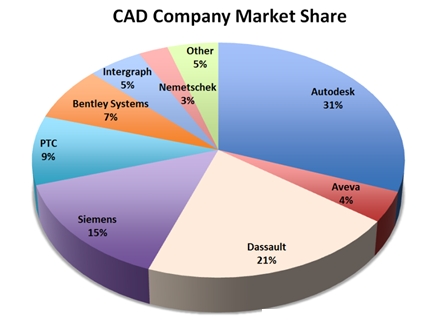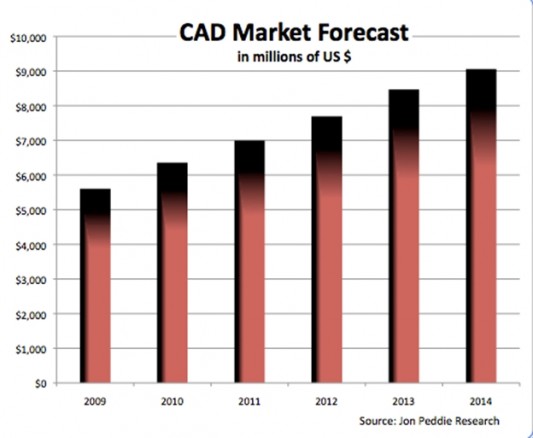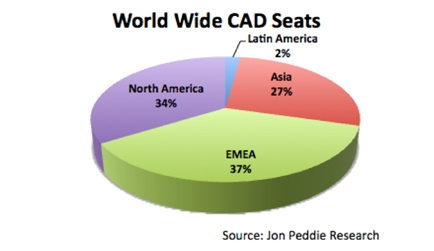Pockets of economic uncertainty remain, but 2012 is shaping up to be a better year for CAD than 2011. Kathleen Maher updates the JPR CAD Report.
By Kathleen Maher

We are well into 2012 and it’s a good time to update the Jon Peddie Research 2012 CAD Report. How is the industry? So far, so good. We are enduring a fragile global recovery though most people in the West are simply tired of feeling poor and worrying about the future so they are behaving as if everything is going to be great. We’re inclined to agree, but it could well be we too are ready to be optimistic.
In JPR’s 2012 CAD Report, released at the end of 2011, we put the number of CAD users for 2011 at just over 5 million. That means over 5 million seats of CAD were bought or upgraded in 2011. The total number of active users is higher. It includes the people who are continuing to work in the industry using older products or they have subscriptions for CAD products. In 2011 we estimated there were 19.3 million seats of CAD in active use worldwide.
Revenues from CAD software will reach $7 billion in 2012. The highest growth regions will continue to be the BRIC countries, Brazil, Russia, India and China, but the U.S. is shrugging off the recession. Siemens, Bentley, and PTC have all specifically highlighted growth in China. As the world’s CAD companies benefit from China’s growth, China’s homegrown CAD industry is looking for a piece of the action; Beijing-based ZWSoft has considerable resources and is building 2D and 3D programs to target Autodesk and SolidWorks.
In the East, there is uncharacteristic uncertainty. China is showing the effects of rapid change with the upcoming change in leadership. To grotesquely oversimplify, the major question is whether China’s leaders will continue their policy of relative economic freedom coupled with much more limited political freedom. In general, that seems likely, but there are cracks and one of the side effects of the government’s policy has been corruption. There are also signs that the Chinese miracle has its limits just like any other economic miracle. However, by all predictions growth will continue through 2012 and 2013.
The challenge for China is to continue growing its domestic markets to complement the country’s huge but vulnerable export engine. For example, in 2012 the uncertain fortunes of some of the Eurozone countries are affecting China’s export revenues. The country needs to grow its domestic demand for Chinese goods to lessen the threat from decreased demand for exports overseas. However, this is a concern for the future; most see China continuing to help drive economic growth in the entire Asia region.
Autodesk notes with some surprise, that Russia came on strong in 2011 along with much of Eastern Europe, and that Turkey is “going wild.”
International community breathes easier
When our 2012 report was published at the beginning of the year, we said the CAD industry had re-set itself as a result of the recession. We expected to see new growth, but at the time, the situation in Europe was so uncertain that it seemed everything could spiral back down again. There are still problems in Europe and we believe there are hidden problems. While Greece struggles to pay its bills, Italy, and Spain also have problems that could flow through the region. On the other hand, the agony of Greece also presents a stark lesson to its neighbors. As this report is being written there are agreements in place to increase bailout funds for Europe’s problem economies and increasing commitment from G20 countries to help prevent another crisis flare up. Ireland says it has stabilized its economy.
At the end of 2011 we predicted modest growth for 2012. Now, as we near the halfway point, we are more optimistic. We were influenced by the problems in Europe and signs of slowing in China. Those factors still exist but they may be less influential than we thought at the beginning of the year.
Now that we’re a little deeper into 2012, there is a promise of economic stability worldwide and growth to come. Europe will remain slow through 2012 but the Americas are seeing growth and emerging economies continue to pick up the slack. It looks like the balancing act that was smoothing the way for CAD companies is back in place as it was before late 2008-2009. The growth in China, Brazil, Eastern Europe, Russia, and India helps offset the slowing of the more mature economies. In the U.S the housing market is improving; excess inventory finally seems to be moving and there is heady talk of renewed construction.
By the numbers
Because CAD software is used in all aspects of industry (architecture, building, civil engineering, interior design, fabrication, process and power plants, manufacturing, mapping, etc.) it reflects worldwide economic conditions. We think of it as a leading indicator because companies buy CAD seats in anticipation of growth. In the first half of 2012, we’re seeing that play out. Sales of CAD seats in the second half of 2011 and now in 2012 have come ahead of growth in some industries, most notably AEC. Several CEOs including Autodesk’s Carl Bass, Dassault’s Bernard Charles, and Bentley Systems CEO Greg Bentley have said they’re seeing companies stock up on CAD licenses and they are interpreting that as signs of growth.
Greg Bentley, in his call to press and analysts to report Bentley’s performance, said the construction industry had seen several false dawns. But, he also said that as 2011 was drawing to a close, the company has seen the lights come on in building and construction companies as new users are being added and companies are adding more capabilities.
Greg Bentley points out that his company, Bentley Systems, and Autodesk are running neck and neck if you separate out Autodesk’s AEC business and put it up against Bentley’s business. Autodesk knows this and the company has announced wins with several US state departments of transportation (DOTs) and their equivalent internationally as well. Bass says that over the last 12 months, Autodesk has won six DOTs.
There is quite a bit of difference between the two companies however. Bentley has built its business around BIM and its ProjectWise data management core. Autodesk’s BIM tools came on somewhat later and they have not been as integrated with all the Autodesk tools.
For a long time now, Bentley has been growing its business in large infrastructure projects with a wealth of applications that address very specific requirements. A couple of years ago the company debuted a floating license scheme which enabled large companies to sign up with complementary modules of products and swap in and out new modules as needed. Bentley says their customers love it, and Bentley is finding that customers are adding on new modules and keeping them.
Autodesk has been building suites of products and it too is finding that customers like the idea of having solutions put together for them. The company has a great many tools but it does not have as many specific tools as Bentley has. It’s working on that.
On the manufacturing side, we are seeing U.S. companies revive. The manufacturing giants include Dassault Systèmes, Siemens PLM Software, and PTC. All three companies report growth in their CAD business. The US is seeing a return of manufacturing jobs–primarily in durable goods manufacture. Much of the growth is situated in the Eastern portion of the United States with the new growth of the automotive industry.
Not exactly business as usual
Changes have come on the top and on the bottom—meaning that computers are more powerful than ever when it comes to handling large data sets, graphics, and rendering. Bit by bit, the large software vendors are finding jobs for GPUs and putting them to work. Users are gravitating towards complete solutions and adding on capabilities such as analysis, data management, and rendering/visualization. This is benefiting the large companies that are running as fast as they can to become one-stop shops. Interestingly enough, what each company considers to be the critical pieces of the puzzle is different–sometimes slightly, sometimes to a very large extent.
We are also seeing huge interest from users who want to incorporate tools like tablets and iPhones for data visualization, mark-up, and even some light editing. The trend is not at all inconsistent. It is a trend towards end-to-end communications, visualizations, and information updating. Mobile phones have taught all users that they can have access to their information anywhere, and that’s exactly what they want. Tablets are looking like a solution to the long-held dream of companies to have better access to information in the field.
New business models
Autodesk has announced its new PLM product. It’s a cloud-based system and Carl Bass has promised that it will be the answer to many companies’ prayers. While the initial rollout is being built around PLM and designed for manufacture, Autodesk has said the new technology will be useful for many companies in different industries and that this PLM product is just the first step in Autodesk’s plan to offer cloud-based information management and collaborative tools for all of their product lines. Autodesk is building similar tools for its major product groups including Media and Entertainment.
Taking a page from competitors, Autodesk has added a subscription model that lets users turn on their CAD products as they need them. It’s similar to Bentley’s system and Adobe is likewise turning to this kind of model. This is a model that makes sense for companies that routinely depend on certain software products. The benefit to the companies offering the subscription is that it evens-out the boom and bust cycle of major product introductions. The model is coming to dominate the CAD industry and several companies report over 70% adoption by customers. This is a model that the large enterprise companies have had in place for a long time. The increasing acceptance of the cloud and the (relative) ease of use that comes with it are finally pushing these models down into the mainstream. We find this a big improvement in the way people work. It’s as revolutionary as company networks once were and it helps complete the puzzle.

Time for growth
Although it would be wrong to paint 2011 as a down year for the CAD industry, the picture is brighter than it was this same time last year. 2011 did not see the hoped-for rate of growth. Looking back we now know there was a great deal going on beneath the surface as the major companies struggle with new business models, restructuring, new platforms, and in some cases, new architectures. It’s reasonable to expect a period of good and sustained growth to follow a period of recession. And when there has been a worldwide recession affecting all industries, it is even more reasonable to expect growth to follow. The challenge is living through it and understanding what is happening all around. On one hand, we are impatient for growth and on the other we fail to recognize it when it arrives. Now, even the most pessimistic forecaster is seeing growth in both manufacture and AEC, the major CAD segments.
Kathleen Maher is Editor-in-Chief of GraphicSpeak, and Managing Editor of TechWatch, both published by Jon Peddie Research.







